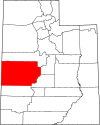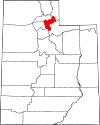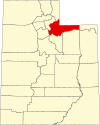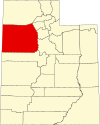List_of_counties_in_Utah
List of counties in Utah
Administrative subdivisions of Utah
There are 29 counties in the U.S. state of Utah. There were originally seven counties established under the provisional State of Deseret in 1849: Davis, Iron, Sanpete, Salt Lake, Tooele, Utah, and Weber.[1] The Territory of Utah was created in 1851 with the first territorial legislature meeting from 1851–1852. The first legislature re-created the original counties from the State of Deseret under territorial law as well as establishing three additional counties: Juab, Millard, and Washington. All other counties were established between 1854 and 1894 by the Utah Territorial Legislature under territorial law except for the last two counties formed, Daggett and Duchesne. They were created by popular vote and by gubernatorial proclamation after Utah became a state.[2] Present-day Duchesne County encompassed an Indian reservation that was created in 1861. The reservation was opened to homesteaders in 1905 and the county was created in 1913.[3] Due to dangerous roads, mountainous terrain, and bad weather preventing travel via a direct route, 19th century residents in present-day Daggett County had to travel 400 to 800 miles (640 to 1,290 km) on both stage and rail to conduct business in Vernal, the county seat for Uintah County a mere 50 miles (80 km) away. In 1917, all Uintah County residents voted to create Daggett County.[4]
Based on 2022 United States Census data, the population of Utah was 3,380,800. Just over 75% of Utah's population is concentrated along four Wasatch Front counties: Salt Lake, Utah, Davis, and Weber. Salt Lake County was the largest county in the state with a population of 1,186,257, followed by Utah County with 702,434, Davis County with 369,948 and Weber County with 269,561. Daggett County was the least populated with 1,014 people. The largest county in land area is San Juan County with 7,821 square miles (20,260 km2) and Davis County is the smallest with 304 square miles (790 km2).[5]
The Federal Information Processing Standard (FIPS) code, which is used by the United States government to uniquely identify states and counties, is provided with each county.[6] Utah's FIPS code is 49, which when combined with any county code would be written as 49XXX. In the FIPS code column in the table below, each FIPS code links to the most current census data for that county.[7]
The Utah Code (Title 17, Chapter 50, Part 5) divides the counties into six classes by population:[8]
- First class: Population of 1,000,000 or more. Only one county - Salt Lake - is first class.
- Second class: Population between 175,000 and 1,000,000. Four counties.
- Third class: Population between 40,000 and 175,000. Five counties.
- Fourth class: Population between 11,000 and 40,000. Ten counties.
- Fifth class: Population between 4,000 and 11,000. Five counties.
- Sixth class: Population below 4,000. Four counties.
The county classes, for example, are used in the Utah legislature in crafting of legislation to distinguish between more urban and rural areas, such as important yet subtle distinctions in how revenue can be distributed. Usually, a bill intended to benefit rural counties would target the counties of the fourth, fifth and sixth class.[9]
Under Utah Code (Title 17, Chapter 52a, Part 2), Utah counties are permitted to choose one of four forms of county government:[10] a three-member full-time commission; a five or seven member expanded commission; a three to nine member (odd-numbered) part-time council with a full-time elected county mayor or a three to nine member (odd-numbered) part-time council with a full-time manager appointed by the council. 23 out of 29 counties are ruled by the standard three-member commission. Of the other six, Cache County was the first change in 1988 to a seven-member council with an elected mayor. Grand County adopted a seven-member council with appointed manager in 1992, followed by Morgan County in 1999 and Wasatch County in 2003. In 1998, Salt Lake County residents approved adopting a nine-member council with elected mayor that began work in 2001.[11] Summit County adopted a five-member council with an appointed manager in 2006.[12]




























